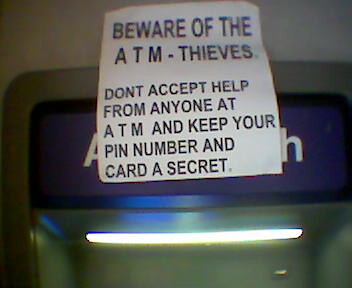"The message of Wikipedia," writes Michael Wesch, "is not 'trust authority' but 'explore authority.' Authorized information is not beyond discussion on Wikipedia, information is authorized through discussion, and this discussion is available for the world to see and even participate in."
This comes from Wesch's January 2009 Academic Commons article,
"From Knowledgable to Knowledge-able: Learning in New Media Environments." The piece is part of an issue dedicated to exactly this problem: How do we teach and learn in a cultural moment where even the very definition of "knowledge," "teaching," and "learning," and even of "information" is being called into question?
Wesch focuses in on the brick-and-mortar university, arguing that despite growing recognition among higher-ed faculty and administration that university teaching and learning desperately needs to shift away from its authoritarian roots, a series of physical, social, and cognitive structures stymie this effort at nearly every turn. The physical deterrents are, Wesch argues, the easiest to recognize, and they
are on prominent display in any large “state of the art” classroom. Rows of fixed chairs often face a stage or podium housing a computer from which the professor controls at least 786,432 points of light on a massive screen. Stadium seating, sound-absorbing panels and other acoustic technologies are designed to draw maximum attention to the professor at the front of the room. The “message” of this environment is that to learn is to acquire information, that information is scarce and hard to find (that's why you have to come to this room to get it), that you should trust authority for good information, and that good information is beyond discussion (that's why the chairs don't move or turn toward one another). In short, it tells students to trust authority and follow along.
This is a message that very few faculty could agree with, and in fact some may use the room to launch spirited attacks against it. But the content of such talks are overshadowed by the ongoing hour-to-hour and day-to-day practice of sitting and listening to authority for information and then regurgitating that information on exams.
These are a key feature of the social structures that work against change in higher education: The ongoing pressure to standardize curriculum and use (easily quantified) standardized assessments for accountability purposes. Wesch writes:
When I speak frankly with professors all over the world, I find that, like me, they often find themselves jury-rigging old assessment tools to serve the new needs brought into focus by a world of infinite information. Content is no longer king, but many of our tools have been habitually used to measure content recall. For example, I have often found myself writing content-based multiple-choice questions in a way that I hope will indicate that the student has mastered a new subjectivity or perspective. Of course, the results are not satisfactory. More importantly, these questions ask students to waste great amounts of mental energy memorizing content instead of exercising a new perspective in the pursuit of real and relevant questions.
This is, perhaps, one of the most significant dangers inherent in re-mediating assessment: The risk of re-mediating the
wrong aspects of current assessment strategies. Rewriting a multiple-choice test is surely not the answer, but it's often, and understandably, what innovative and new media-friendly educators do. The results of this effort may not be satisfactory, after all, but they're better than nothing. And short of overhauling an entire course, it's often a useful stopgap measure.
And what of overhauling an entire course? Wesch, recognizing that "our courses have to be
about something," argues for a shift away from "subjects" (English, History, Science) and toward "subjectivities"--ways of approaching and thinking about content. One simple way of thinking about this shift is by thinking about the difference between learning the steps of the scientific method and developing the mindsets embraced by a profession that embraces the scientific method as a useful approach to experimentation.
The "subjectivities" approach is, in fact, the favored approach of many graduate programs. My sister, who is beginning law school this fall, is immersed in a cognitive apprenticeship designed to make her think, act, and speak like a lawyer. As a new doctoral student in Indiana University's Learning Sciences program, I'm undertaking the same apprenticeship. A series of courses, including IU's Professional Seminar in the Learning Sciences and Theory and Method in the Learning Sciences, are intended to equip new grad students with the Learning Sciences mindset.
This approaches, however, gives rise to a key question: If the "subjectivities" approach is intended to is intended to help learners think, act, and speak like a {fill in the blank}, then who decides
how a {fill in the blank} is supposed to think, act, and speak?
Jim Gee offers a fascinating critique of "learning to think like a lawyer" in his book Social Linguistics and Literacies. He argues that success in law school is slanted toward people who think, act, and speak like white, middle-class men, explaining that:
[t]o write a competent brief the student has to be able to read the text being briefed in much the same way as the professor does.... Students are not taught these reading skills—the ones necessary to be able to write briefs—directly. Briefs are not, for instance, turned in to the professor; they are written for the students' own use in class.... One of the basic assumptions of law school is that if students are not told overtly what to do and how to proceed, this will spur them on essentially to teach themselves. Minnis argues that this assumption does not, however, work equally well for everyone. Many students from minority or otherwise non-mainstream backgrounds fail in law school.
(A female friend who recently completed law school agrees with this argument, and struggled mightily with the inequities inherent in her program and inside the field of law in general. I've written about her experience
here.)
This issue is certainly not limited to law school; it's a thorny problem in every program designed to help students think like a {fill in the blank.} I understand that this is an issue that IU's Learning Sciences program has grappled with recently, and I imagine this is the reason that the Professional Seminar in the Learning Sciences, previously a required course, has now been made optional.
What do I know, right? I haven't even started my first semester in the program yet. But it seems to me that if this issue is worth grappling with (and I believe it is), it's worth grappling with
alongside of the program's apprentices. I'm for making the course mandatory and then using it to expose, discuss, and clarify the very issues that led to the faculty's decision.
Here we can take a page out of the Wikipedia lesson book. There's no point in simply trusting authority when the social revolution supports not just questioning, not just opposing, but actually
exploring authority. After all, thinking like a good {Learning Scientist} is about much more than embracing a set of approaches to teaching, learning, and knowledge; it's also about questioning, contesting and exploring the very foundation of the field itself.
 This year, the South by Southwest Interactive Festival is crowdsourcing its lineup of panelists by allowing people to vote thumbsup or thumbdown on panel proposals.
This year, the South by Southwest Interactive Festival is crowdsourcing its lineup of panelists by allowing people to vote thumbsup or thumbdown on panel proposals. I recently submitted my proposal, which is on the Free / Libre / Open Education (FLOE) movement.
I recently submitted my proposal, which is on the Free / Libre / Open Education (FLOE) movement. 




























